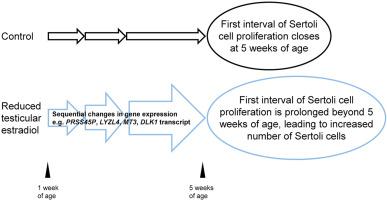Molecular and Cellular Endocrinology ( IF 4.1 ) Pub Date : 2020-12-01 , DOI: 10.1016/j.mce.2020.111099 Trish Berger 1 , Simin Tang 1 , Lien Tu 1 , Delia Alba Soto 1 , Alan J Conley 2 , Barbara Nitta-Oda 1

|
Porcine Sertoli cell number including number present at puberty is increased if testicular estradiol synthesis is reduced during the neonatal interval. Evaluating the changes in gene expression during the crucial interval of suppressed estradiol that leads to the increased Sertoli cell population will increase our understanding of Sertoli cell biology but this evaluation first required a more precise determination of the critical interval for treatment and timing of a detectable response. Previously, reduced testicular estrogens from 1 week of age were accompanied by increased Sertoli cell number at 6.5 weeks of age but the age at which Sertoli cell numbers were initially increased was unknown, one of the current objectives. Additional experiments were designed to further delineate the essential timing of treatment for the Sertoli cell response. Finally, changes in gene expression induced by the reduced estradiol synthesis were evaluated to elucidate molecular mechanisms. Experimental design typically consisted of one member of littermate pairs of boars treated with the aromatase inhibitor, letrozole, beginning at 1 week of age and the remaining member treated with canola oil vehicle. Weekly treatments continued through 5 weeks of age or tissue collection, whichever came first. Increases in Sertoli cell numbers were not detectable prior to 6.5 weeks of age and persistent treatment through 5 weeks of age was required to induce the increase in Sertoli cell numbers. This increase resulted from prolonging the first interval of Sertoli cell proliferation in the treated animals. Few genes exhibited dramatically altered transcription and similarities in pathway analysis or principal modified genes were quite limited in 2, 3, and 5-week-old boars. The critical timing and prolonged treatment required and the sequential changes in gene expression suggest a complex mechanism is involved in this model of increased proliferation of Sertoli cells.
中文翻译:

雌二醇合成减少后睾丸基因表达的变化:增加猪支持细胞增殖的复杂途径
如果在新生儿期睾丸雌二醇合成减少,则猪支持细胞数量(包括青春期存在的数量)会增加。评估导致支持细胞群增加的受抑制雌二醇关键间隔期间基因表达的变化将增加我们对支持细胞生物学的理解,但该评估首先需要更精确地确定治疗的关键间隔和可检测反应的时间. 以前,从 1 周龄开始睾丸雌激素减少伴随着 6.5 周龄时支持细胞数量的增加,但支持细胞数量最初增加的年龄是未知的,这是当前的目标之一。额外的实验旨在进一步描绘支持细胞反应的基本治疗时间。最后,评估由减少的雌二醇合成引起的基因表达的变化以阐明分子机制。实验设计通常包括在 1 周龄开始用芳香酶抑制剂来曲唑处理的同窝公猪对中的一个成员和用菜籽油载体处理的其余成员。每周治疗持续到 5 周龄或组织收集,以先到者为准。在 6.5 周龄之前检测不到支持细胞数量的增加,需要持续治疗到 5 周龄才能诱导支持细胞数量的增加。这种增加是由于延长了治疗动物中支持细胞增殖的第一个间隔。在 2、3 和 5 周龄公猪中,很少有基因表现出显着改变的转录和通路分析中的相似性或主要修饰基因非常有限。所需的关键时机和延长治疗时间以及基因表达的连续变化表明,这种支持细胞增殖增加的模型涉及一个复杂的机制。


























 京公网安备 11010802027423号
京公网安备 11010802027423号